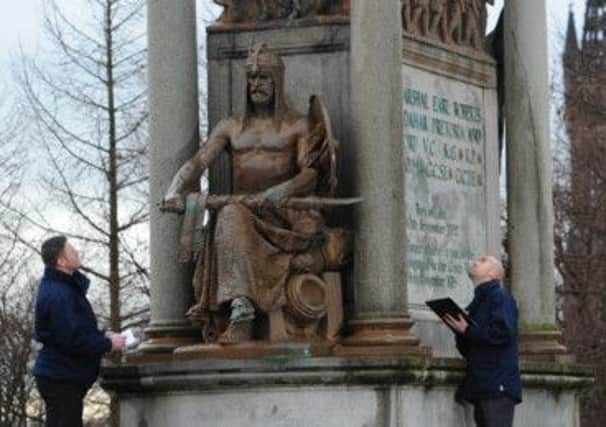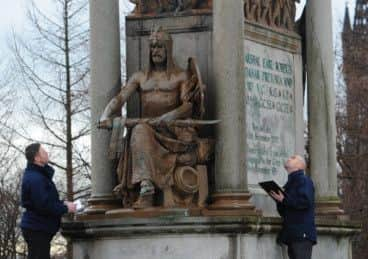Glasgow 2014: £800,000 revamp for Kelvingrove Park


Kelvingrove Park in Glasgow, which will host the lawn bowls events, will have its main gateways and key monuments restored as part of the major spruce-up.
The overhaul by Glasgow City Council, which starts next month and is due to be completed by June, will also include new fencing, footpath repairs and tree work.
Advertisement
Hide AdAdvertisement
Hide AdTwo million people a year visit Scotland’s first purpose-built park, which is 162 years old, and many thousands of new visitors, in the city for the Games, are expected to visit this summer.


The 85-acre west end site beside Glasgow University’s main campus is home to Kelvingrove Art Gallery and Museum, one of the country’s most popular free attractions.
The work will include refurbishing four of the park’s entrances and six statues, several of which are grade A-listed.
David Howat, secretary of Friends of Glasgow West, said: “The Games will bring many benefits and it’s important that visitors who wander from the venues see the city at its best. The Games have galvanised the city council to do what needs done.”
It comes after other enhancements which included the opening of a cafe in the park and the restoration five years ago of the Stewart Memorial Fountain, which commemorates the completion of Glasgow’s water supply system from Loch Katrine in the Trossachs.
The park is due to get a further boost this summer with the re-opening of its bandstand and amphitheatre after a £1.8 million restoration following more than a decade of dereliction.
Elaborate wrought iron gates at the Jubilee gateway, which forms the main southern access to the park from Parkgrove Terrace, will be returned from storage following restoration. The red sandstone gate piers, which date back to 1897, will also be refurbished.
At the east end of the park, the 1855 entrance gate from elegant Park Terrace will be upgraded, along with balustrades along the park boundary, which are both A-listed.
Advertisement
Hide AdAdvertisement
Hide AdRepairs will also be made to the nearby giant monument to Lord Frederick Roberts, acclaimed as the “saviour of the British Empire” for leading military campaigns in India and South Africa.
The 1916 memorial to Roberts was funded by public subscription among Glaswegians who regarded the Victoria Cross winner as a national hero. He is believed to have been an inspiration for George Macdonald Fraser’s Flashman novels. The bronze sculpture of Roberts on his favourite Arab charger Volonel was described when erected as “the finest equestrian statue of modern times”.
Conservationists described the work came as a “fabulous spin-off” from the Commonwealth Games.
Howat said he especially welcomed the return of the Jubilee gates, which he said would form a “magnificent entrance” to the park. He also hoped trees would be cleared to restore the more views from the park across to Glasgow University’s 280ft high tower.
Other statues to be refurbished include the Royal Bengal Tigress With Peacock, which was the first sculpture to be erected in the park in 1867. The bronze artwork by Auguste Nicolas Cain was gifted to the city by Glasgow-born millionaire John S Kennedy, who saw the award-winning original in Paris.
Four statues by Paul Raphael Montford on the Kelvin Way bridge over the River Kelvin, which are a century old this year, will also be overhauled.
Situated on each quadrant of the bridge, the figures represent philosophy and inspiration (north-west), war and peace (north-east), navigation and shipbuilding (south-east) and commerce and industry.
The war figure was badly damaged in an air raid during the Second World War and restored in 1951,
Advertisement
Hide AdAdvertisement
Hide AdThe council has plans to restore Kelvin Way to how it looked in Victorian times, with Kelvingrove Art Gallery and Glasgow University.
Alistair Watson, the city council’s executive member for land and environmental services, said:“Kelvingrove Park is one of the best-known and loved of the city’s parks, and these restoration works are designed to have it looking at its very best this summer.”
Other areas of the park to be upgraded include its northern entrance from Eldon Street, and the western entry from Dumbarton Road.
Ahead of the main work, a memorial garden beside the River Kelvin to former Glasgow art galleries and museums director Dr Tom Honeyman is being overhauled.
Kelvingrove, which was originally known as The West End Park, was laid out by Sir Joseph Paxton between 1852 and 1867. It hosted International Exhibitions in 1888 and 1901.
A spokeswoman for Historic Scotland said: “We welcome these works to Kelvingrove Park, which, with its associated buildings and monuments, is one of Glasgow’s most important attractions.
“We hope the historic monuments that will be restored as part of this project will be enjoyed by Glaswegians and visitors to the city alike.”